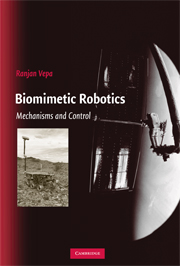Book contents
- Frontmatter
- Contents
- Preface
- Acronyms
- 1 The Robot
- 2 Biomimetic Mechanisms
- 3 Homogeneous Transformations and Screw Motions
- 4 Direct Kinematics of Serial Robot Manipulators
- 5 Manipulators with Multiple Postures and Compositions
- 6 Grasping: Mechanics and Constraints
- 7 Jacobians
- 8 Newtonian, Eulerian, and Lagrangian Dynamics
- 9 Path Planning, Obstacle Avoidance, and Navigation
- 10 Hamiltonian Systems and Feedback Linearization
- 11 Robot Control
- 12 Biomimetic Motive Propulsion
- Answers to Selected Exercises
- Appendix: Attitude and Quaternions
- Bibliography
- Index
Appendix: Attitude and Quaternions
Published online by Cambridge University Press: 20 February 2010
- Frontmatter
- Contents
- Preface
- Acronyms
- 1 The Robot
- 2 Biomimetic Mechanisms
- 3 Homogeneous Transformations and Screw Motions
- 4 Direct Kinematics of Serial Robot Manipulators
- 5 Manipulators with Multiple Postures and Compositions
- 6 Grasping: Mechanics and Constraints
- 7 Jacobians
- 8 Newtonian, Eulerian, and Lagrangian Dynamics
- 9 Path Planning, Obstacle Avoidance, and Navigation
- 10 Hamiltonian Systems and Feedback Linearization
- 11 Robot Control
- 12 Biomimetic Motive Propulsion
- Answers to Selected Exercises
- Appendix: Attitude and Quaternions
- Bibliography
- Index
Summary
Defining Attitude: Frames of Reference
The motion of a rigid body can be specified by its position and attitude. The first quantity describes the translational motion of the center of mass of the body. The latter quantity describes the rotational motion of the body about an axis passing through the center of mass. In general, the position and attitude are independent. The attitudinal motion can be considered to consist of two aspects: attitude kinematics and attitude dynamics. Attitude kinematics is the fundamental description of changes in attitude with time without any consideration of the torques applied to the body. On the other hand, attitude dynamics refers to the motion of a body in response to applied torques. The main aspect in the kinematics of attitude is the description of the attitude or orientation of a body in space, which is the subject of this appendix. To define the orientation of the body in space, we begin by defining three mutually perpendicular axes fixed in the body at its center of gravity. The body axes are a right-handed triple of orthogonal axes. The orientation or attitude of a rigid body is then defined as the orientation of the body axes relative to a set of reference axes. A frame fixed in space defines a reference axes system and is said to be an inertial frame. The reference axes are a right-handed triple of orthogonal axes. Typically a set of three mutually orthogonal axes constitutes a right-handed reference frame when there is a right-handed clockwise screw rotation of the x axis toward the y axis points to the z axis.
Information
- Type
- Chapter
- Information
- Biomimetic RoboticsMechanisms and Control, pp. 317 - 334Publisher: Cambridge University PressPrint publication year: 2009
